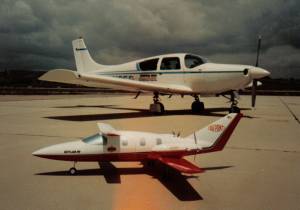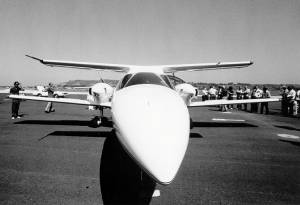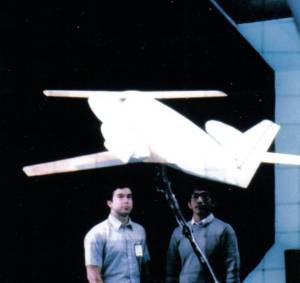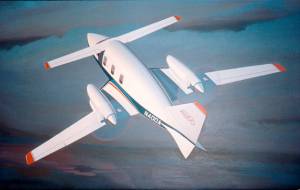AvtekAir History
Mr. Robert D. Honeycutt, Mr. Quinten E. Ward and others joined in the development of the Avtek Corporation during the 1980s to create the airplane that is now designated the AvtekAir 9000T.
The Avtek Corporation was dissolved on December 3, 1998 under Chapter 7 of the U.S. Bankruptcy Code. All of its assets, including the research data, plans for the aircraft that is now the AvtekAir 9000T, and Proof-of-Concept airplane, were purchased by Mr. Ward personally as part of the Bankruptcy proceeding.
Mr. Ward formed the Aeroco Corporation as a Nevada corporation on November 2, 1998. Its Board of Directors voted on December 18, 1998 to change the name of the corporation to AvtekAir, Incorporated. Papers have been filed to effect this change.
Concept
During the initial development phase of the aircraft, Mr. Honeycutt joined with a group of aviation marketing analysts and engineers to determine the ideal parameters for an aircraft that they believed would satisfy a serious need in the business aircraft market. Their original performance specification goals for seating capacity, speed, range, fuel economy and sales price have been realized in the AvtekAir 9000T production aircraft. The engineering group determined that to achieve these goals, the following elements were needed:
- A lightweight, advanced-composite airframe
- Turboprop engines with counter-rotating propellers
- Unique construction and manufacturing techniques to maintain the targeted sales price
- An exceptionally qualified engineering and design team
- Extensive support from major prospective suppliers, such as Pratt & Whitney (engines), E.I. DuPont de Nemours & Co (Kevlar and Nomex), Dow Chemical (epoxy resins and composite patents), Hartzell (propellers) and others.
It was determined that because of the advanced nature of the concept a "Proof-of-Concept" prototype airplane would need to be built. To design and build this prototype would require two distinct technology development programs: aerodynamic design and composite structures.
Outstanding people working in these two disciplines were identified and recruited for the aircraft development project.
The "Experts Team"

|
|
RC (radio-controlled) model of the Avtek 400 in front of the Windecker Eagle. |
The predecessor of AvtekAir was able to attract an exceptional group of aeronautical engineering and design experts, including nine FAA Designated Engineering Representatives (DERs), and to win promised support from the major prospective suppliers listed above.
The original conceptual aircraft configuration was sketched on a piece of paper by Al Mooney, the founder of the Mooney Aircraft Company and one of the pioneers of aviation design. This sketch was transferred to a computer and the design was analyzed.
In 1982, 1/10th and 1/5th scale radio-controlled models were built and tested. From the data derived in these tests, a full-sized prototype, "Proof-of-Concept", aircraft was designed and built by the predecessor of AvtekAir's Team at facilities in Camarillo, California between 1982 and 1984.
Proof-of-Concept (POC) Airplane and Wind Tunnel Model

|
|
Rollout of the Avtek 400 P.O.C. aircraft. |
The "Proof-of-Concept" test airplane obtained an FAA Special Airworthiness Certification and made its first flight in September 1984. Testing the "Proof-of-Concept" airplane to Federal Aviation Regulations (FAR) Part 23 Standards continued for another two years.
The "Proof-of-Concept" airplane tested computer analytical predictions of the airplane's performance. Head engineer and FAA Designated Engineering Representative (DER), Niels Andersen, states that the analytical predictions were conservative and he was therefore surprised that the actual performance characteristics of the airplane matched the predictions so closely. He concluded that the methods used to analyze the POC airplane were valid because the airplane displayed the characteristics predicted in the analytical report.
Mr. Andersen has great confidence that the AvtekAir 9000T production model will have no difficulty meeting its guaranteed specifications during the FAA Certification Program.
The POC airplane logged more than 150 hours in the testing program. Based on the analytical predictions and actual flight characteristics, 160 refinement-type changes were made in the POC. These included some changes for passenger comfort, such as lengthening the fuselage by 56 inches and reducing the taper of the fuselage so that the rear of the cabin has more headroom. Other changes were aerodynamic, such as sweeping the leading edge of the wing by 15 degrees, lowering the engines to rest on top of the spar to reduce drag, and adding large fuel strakes to hold fuel closer to the center of gravity.

|
|
The AvtekAir 9000T in the NASA Langley wind tunnel, here still without the ventral strakes now present in the production version. |
These changes were incorporated into a wind tunnel model that was built at the Camarillo facility. In 1986, the 1/5th scale wind tunnel model was tested at the NASA wind tunnel in Langley, Virginia. Based on the NASA results, 14 additional refinements were made to the design, including adding delta fins on the rear of the plane for greater deep stall or upset control at high altitudes. NASA then analyzed the wind tunnel data and design data on a supercomputer at their Lewis Research Center, Cleveland, Ohio, and Ames Research Center, Moffett Field, California.
All changes to the design of the POC airplane were proposed by FAA DERs, who were continually mindful of FAA Part 23 Certification requirements. These DER consultants are the people who will be certificating the AvtekAir 9000T for the FAA. Thus, every change actually decreased the risk that any element of the 9000T production model will be in conflict with Part 23 Certification standards. The result is the final design and configuration of the 9000T production model.
The AvtekAir 9000T Airplane

|
|
Painting of the Avtek 9000T production design |
The 9000T is the result of the tests conducted over the years with the radio-controlled model, the POC airplane, and the wind tunnel model. The 9000T is the airplane that will be certificated by the FAA for production. The analytical models that performed so well in predicting the characteristics of the POC airplane and the wind tunnel models have predicted that the 9000T will easily meet all of its guaranteed performance specifications for speed, range and fuel economy during FAA Certification and production.
Evolution of the Aircraft - Beginning of FAA Certification
Concurrent with the aerodynamic structure design and development, engineers were moving forward on composite structure technology, learning construction techniques for fabricating the parts and assembling them into an airframe. In 1982, Dr. Leo Windecker was approached and invited with his engineering staff to participate in the development effort. Dr. Windecker and his staff obtained the FAA Type Certification for the Windecker "Eagle", the first all-composite aircraft to be certificated by the FAA. Dow Chemical financed the "Eagle" Certification and the development of a family of patents authored by Dr. Windecker and owned by Dow Chemical. A license to use 39 of these patents was purchased from Dow. These patents were utilized in the development and building of the "Proof-of-Concept" prototype airplane.
E.I. DuPont de Nemours & Co was contacted as the manufacturer of Kevlar and Nomex to provide data and technology on these composite materials and access to testing facilities. Dr. Paul McCready, who built the world's lightest airplane out of Kevlar and Mylar, the "Condor", was asked by DuPont to evaluate the AvtekAir aircraft project. After Dr. McCready's report was completed, DuPont invested in the project and provided valuable technical support in the early stages of development of the aircraft.
At this point a number of consultants were brought in to develop process engineering for fabricating, assembling and testing the composite material parts. These aerospace consultants ranged from Dr. Anderson Plummer, an expert on lightning strike analysis, to Leonard Marchinski a DER expert on manufacturing composite airframe structures.
As composite structures were designed and built, they were continually tested to make sure that they met FAA Certification requirements. Accordingly, approximately 45% of the FAA Certification Program in terms of cost and 40% in time have been completed for the 9000T.
P.O.C. Research Corporation
The Founders of Avtek Corporation formed the P.O.C. Research Limited Partnership in May, 1983, and incorporated it in Delaware in 1986 as a debt-free entity that would act as the repository to protect all technology developed as part of the aircraft development program. The POC Partnership and subsequent Corporation were created to take advantage of Federal Tax Code provisions that encouraged investment in research and development entities.
P.O.C. Research Corporation formerly owned all rights to technology developed under contract with the Avtek Corporation for the "Proof-of-Concept" test airplane and for the predecessor aircraft to the AvtekAir 9000T. Quinten E. Ward, Chairman of AvtekAir Incorporated, now owns all of these rights.